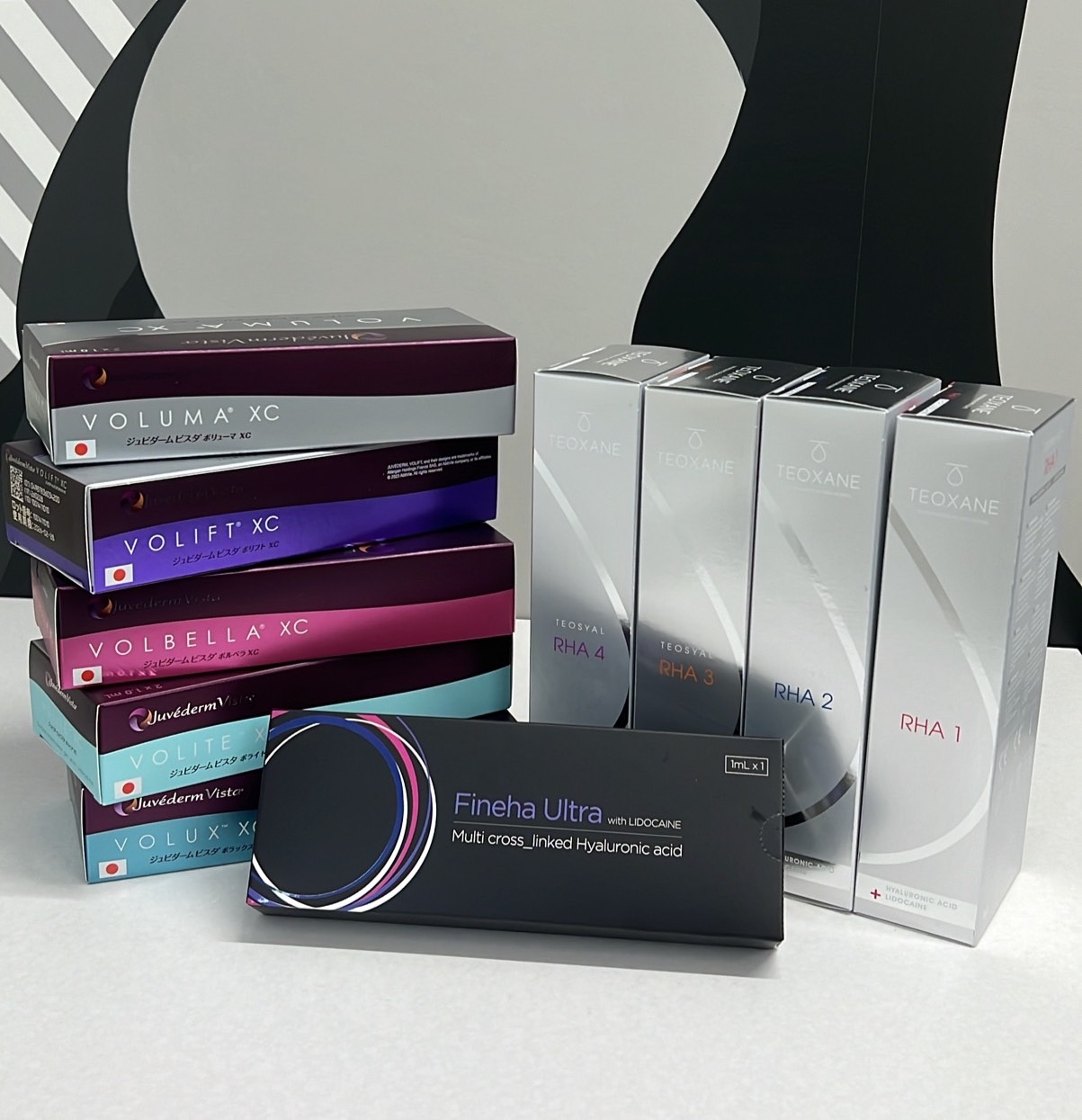
About Hyaluronic Acid
Hyaluronic acid comes in various types, and there are different ways to classify them. In this article, I will explain the classification based on hardness.
The most popular type of hyaluronic acid used at our clinic is the Juvederm Vycross series, created by Allergan.
The types, in order of hardness, are: Volux, Voluma, Volift, Volbella, and Volite.
Volux is the hardest and is used for areas like the nose, chin, and the base of the nasolabial folds. It lasts longer, and based on our clients' experiences, it can last nearly two years.
Voluma has the perfect hardness for ease of use. It gives volume when injected into areas like the base of the nasolabial folds, but it’s also less likely to cause lumps when injected under the skin. It is versatile and can be used for the nasolabial folds, cheeks, temples, and more.
Volift is a good hardness for the fat layer, and it is typically used for areas like thin-skinned cheeks, nasolabial folds, and marionette lines.
Volbella is soft and is used for areas like the tear troughs and lips.
Volite is very fluid and is used for skin texture improvement (enhancing moisture retention).
Very rarely, some people may not respond well to the Juvederm series. For these individuals, the RHA series is recommended.
Additionally, for those who wish to add height to the nasal bridge, Volux may flow, so we also offer Pinéa, which is even harder.
Effects of Hyaluronic Acid
The effects of hyaluronic acid can be broadly divided into two categories.
The first is the effect of adding volume.
Injecting hyaluronic acid into the chin can help define the chin's shape and contour, while injecting it into the nasolabial folds or marionette lines can fill in the indentations and improve wrinkles. Injecting it into the tear troughs, lips, forehead, or nose can help shape those areas as desired. Additionally, injecting it into the upper or outer parts of the cheeks provides a lifting effect.
The second effect is moisture retention. After injecting hyaluronic acid into the lips, for instance, you may notice not only a change in shape but also an improvement in skin quality.
Volite is particularly effective for enhancing moisture retention as it is injected superficially into the skin, allowing the hyaluronic acid to show its moisturizing benefits.
This gives the skin a firm, plump appearance that resembles baby-like skin.
Hyaluronic Acid for Nasolabial Folds
To improve nasolabial folds, we consider whether to address sagging or indentation.
To address sagging, options include surgery, thread lifts, or non-invasive treatments like HIFU, which has a short downtime.
Improving sagging with hyaluronic acid is more challenging, but injecting into the edge of the cheekbones or the outer part of the cheek can result in a slight improvement.
To address indentations, options include fat grafting, regenerative medicine, and hyaluronic acid injections.
Fat grafting involves liposuction to harvest fat and inject it into the area. We do not perform this procedure at our clinic.
Regenerative medicine, which uses substances like FGF to add volume, is also not available at our clinic.
Hyaluronic acid injection involves directly filling the indentation with hyaluronic acid to fill wrinkles.
Changes can be observed immediately, allowing for fine adjustments and careful design to avoid excessive volume or asymmetry.
The type of hyaluronic acid used depends on the injection layer.
Harder types like Volux and Voluma are suitable for deeper layers, while softer types like Volift are used for more superficial layers.
By classifying the treatment for nasolabial folds in this way, it is easier to understand the approach.
Hyaluronic Acid for Tear Troughs
For the tear troughs, soft hyaluronic acid products like Volbella are used.
When injected more towards the inner corner of the eye, the tear trough becomes more prominent, while a more natural look is achieved by avoiding injection near the inner corner.
A design that lowers the outer corner of the eye gives a "droopy" appearance, while focusing more on the center creates a rounder eye impression.
For a natural result, about 0.3 cc is usually enough, while 0.5 cc can be used for a more pronounced effect.
Hyaluronic Acid Side Effects
The major side effects of hyaluronic acid are allergic reactions, infection, and blood flow disorders.
Allergic reactions can occur immediately or may take some time to appear.
Immediate symptoms include swelling or itching.
Delayed reactions may result in lumps or redness.
These can be treated with anti-allergy medication or dissolving the product.
Infections typically present with pain and swelling. They can be treated with antibiotics, and if the infection does not resolve, the product may be dissolved.
Blood flow disorders often present with severe pain and skin discoloration, though other unclear symptoms may appear.
In cases where something feels "off," it may later be determined that it is a blood flow disorder.
If blood flow disorder is suspected, the product should be dissolved immediately.
Yoshiko Kuno
